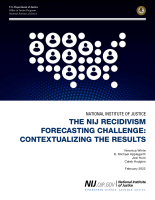Adult correctional facilities
Reducing Institutional Disorder: Using the Inmate Risk Assessment for Segregation Placement to Triage Treatment Services at the Front End of Prison Sentences
Tailoring to a Mandate: The Development and Validation of the Prisoner Assessment Tool Targeting Estimated Risk and Needs (PATTERN)
Effect of Administrative Segregation on Prison Order and Organizational Culture
Gang Affiliation and Restrictive Housing in U.S. Prisons
Modified TC for MICA Offenders: Crime Outcomes
Making the Most of Second Chances: An Evaluation of Minnesota's High-Risk Revocation Reduction Reentry Programs
An Outcome Evaluation of a Prison Work Release Program: Estimating Its Effects on Recidivism, Employment, and Cost Avoidance
The Impact of Prison-Based Treatment on Sex Offender Recidivism
Can Faith-Based Correctional Programs Work? An Outcome Evaluation of the InnerChange Freedom Initiative in Minnesota
Poly-Victimization Risk in Prison: The Influence of Individual and Institutional Factors
Reentering Women: The Impact of Social Ties on Long-Term Recidivism
Crime and Justice: A Review of Research, Volume 28
The NIJ Recidivism Forecasting Challenge: Contextualizing the Results
The imprisonment-extremism nexus: Continuity and change in activism and radicalism intentions in a longitudinal study of prisoner reentry
Booker and Beyond Analyzing Sentencing Reform and Exploring New Research Directions
This webinar features a discussion of previously published research on the U.S. Supreme Court’s 2005 Booker decision - which effectively transformed the United States Sentencing Guidelines from a mandatory, to an advisory, system. The presentation will address selected research findings from the last 15 years. Individual participants will briefly review their previous research findings with particular attention paid to the analytic methods used.
See the YouTube Terms of Service and Google Privacy Policy
What if They Are All High-Risk for Attrition? Correlates of Retention in a Longitudinal Study of Reentry from Prison
Women in Solitary Confinement: Relationships, Pseudofamilies, and the Limits of Control
2021 Review and Revalidation of the First Step Act Risk Assessment Tool
Multilevel Evaluation of Project Safe Neighborhoods
Project Safe Neighborhoods (PSN) is a DOJ-sponsored initiative to reduce violent crime, particularly gun crime, by fostering cooperation by criminal justice agencies and local partners to develop and implement strategic approaches.
See the YouTube Terms of Service and Google Privacy Policy
Understanding Incarceration and Re-Entry Experiences of Female Inmates and their Children: The Women’s Prison Inmate Networks Study (WO-PINS)
NIJ-Funded Research on Mass Shootings to Advance Evidence-Based Policy and Practice
Mass public shootings continue to threaten communities in the United States, yet research on this criminal phenomenon is limited. In this full thematic panel, renowned experts will present a series of research projects summarizing NIJ-funded research projects’ newest findings on public mass shootings. The discussion will focus on NIJ’s investment to address the phenomenon of mass shootings through innovative study approaches to advance our understanding of mass shootings and inform prevention efforts. The implications of this research to criminal justice will also be discussed.
See the YouTube Terms of Service and Google Privacy Policy
FY 2020 Report to the Committees on Appropriations - Formerly Incarcerated Women and Reentry: Trends, Challenges, and Recommendations for Research and Policy
NIJ-Funded Research on Firearms Violence in Urban Cities Advancing Scientific Evidence to Inform Practice
In this full thematic panel, renowned experts will present a series of papers summarizing the newest findings of NIJ-funded research projects on criminal offenses with firearms in urban areas. Researchers used various criminological and other theories, including routine activity theory, socio-ecological and socio-environmental perspectives, and advanced mixed-study methods, including surveys and spatio-temporal designs, to produce scientific evidence to inform practice.
See the YouTube Terms of Service and Google Privacy Policy
Desistance From Crime: Implications for Research, Policy, and Practice
Most scholars would agree that desistance from crime – the process of ceasing engagement in criminal activities – is normative. However, there is variability in the literature regarding the definition and measurement of desistance, the signals of desistance, the age at which desistance begins, and the underlying mechanisms that lead to desistance. Even with considerable advances in the theoretical understanding of desistance from crime, there remain critical gaps between research and the application of that research to practice.
See the YouTube Terms of Service and Google Privacy Policy






